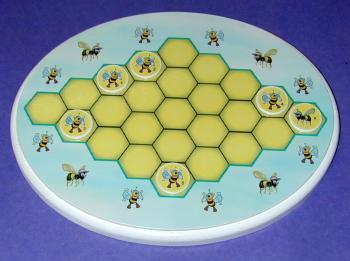
| Designer | : | John Rausch (Based on UFO by Hiroshi Yamamoto) |
| Craftsman | : | John Rausch |
| Category | : | Sequential Movement |
|
Beehive is a variation of the Lunar Lockout puzzle (originally known as UFO) created by Hiroshi Yamamoto. Like Lunar Lockout, Beehive uses a 5x5, but it is a rhombus of hexagonal cells instead of a grid of squares. With hexagonal cells instead of squares, pieces can move in six directions instead of four. While any Lunar Lockout problem can also be solved on the Beehive board, there are thousands of problems where the Beehive has the only or a better (fewer moves or steps) solution.
The queen bee has just returned from her mating flight and is very disoriented and needs help to find her way to the center of the beehive. A secondary objective is to get her therein a specified minimum number of moves. The worker bees provide this help by having her come to them one-by-one and eventually leading her to the center. A move, which is the same for the queen bee and the worker bees, is made in steps. For each step, a bee travels North, Northeast, Southeast, South, Southwest or Northwest towards another bee, stopping in the cell next to the bee moved towards. Travel is stopped only by another bee and must always be towards another piece. After stopping, there are two possible outcomes:
| ||